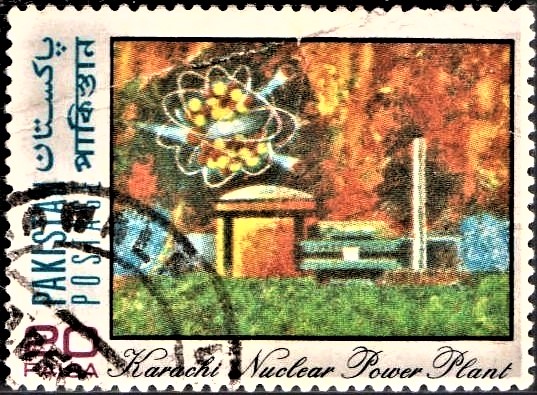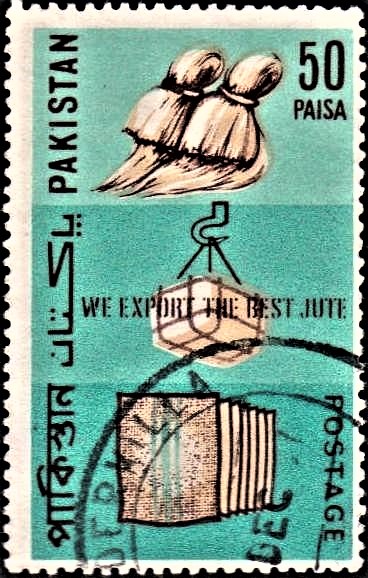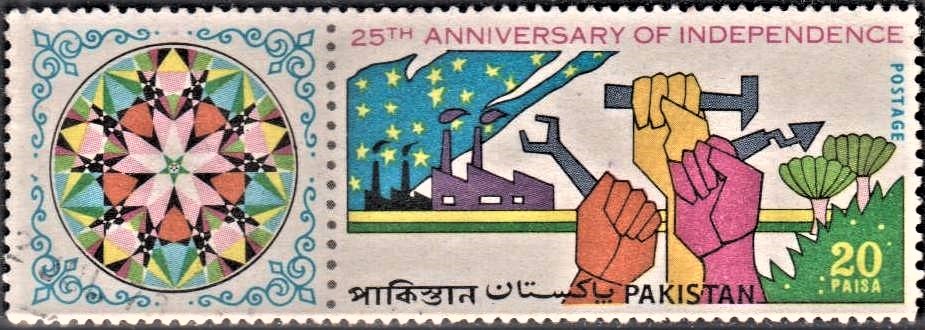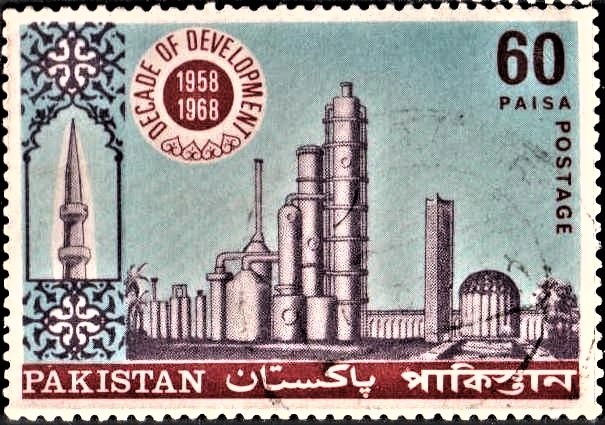
KANUPP (Karachi Nuclear Power Plant)
A commemorative postage stamp on the Karachi Nuclear Power Plant (KANUPP) :
 Issued by Pakistan
Issued by Pakistan
Issued on Nov 28, 1972
Design : The Format of the stamp is horizontal. Within a rectangle, the nuclear power plant is shown near the lower half portion in Red, Yellow and Black colours. The Blue patches on either side of the plant represent “Heavy Water” used in the plant. The lower Green horizontal portion indicates the lawn while the warm back-ground colours (Red, Yellow and Orange) of the sky at the top signify the tremendous heat evolved in the splitting of the atom.
On top left side, the mass of tiny Red and Yellow balls with few orbits around and a few balls emerging out represents the phenomena of ‘Fission of the atom‘ (The above is an artist’s concept of the splitting of Uranium atom).
“Pakistan” in Urdu and Bangla and “Pakistan Postage” appear in blue at the left side of the rectangle while the caption “Karachi Nuclear Power Plant” in script appears at the bottom of the rectangle in Black. The denomination “20” with “Paisa” underneath appears in red in the lower left corner of the stamp.
Type : Stamp, Postal Used
Denomination : 20 Paisa
Colours : Red, Yellow, Blue and Black
Size of Stamp : 44.5 x 32.5 m.m.
Size of Print : 41.5 x 29.5 m.m.
Perforation : 13 x 13 (c)
Quantity printed : 10,00,000
Number of stamps in each sheet : 50
Process of printing : Litho Offset
Printers : The Pakistan Security Printing Corporation Ltd., Karachi
About :
- Facing the Arabian Sea, Pakistan‘s first atomic power station is tucked away on the Buleji Coast, about fifteen miles West of Karachi. Popularly known by its pet-name KANUPP, the Karachi Nuclear Power Plant reflects Pakistan‘s impressive progress in the field of nuclear technology and gives the country the singular distinction of being the first Muslim country and the second developing nation to harness nuclear energy to peaceful purposes.
- The nuclear power plant feeds 125,000 KW into the power grid of Karachi and Hyderabad – two highly industrialized cities of the Province of Sind. About half of the total power requirements of Karachi are currently met from KANUPP.
- The installation of KANUPP, and with it the simultaneous introduction of sophisticated nuclear technology in the country, promises the diffusion of higher technical skills in Pakistan to strengthen its rather feeble engineering base. Foreseeing increasing reliance on nuclear energy to make up for the serious lack of conventional fuel resources, it can be safely concluded that the experience and expertise gained in the installation and operation of the plant would go a long way in implementing the nuclear power programme of the Pakistan Atomic Energy Commission – a programme which envisages the generation of 7000 MW (roughly 1/3rd of the total generating capacity) by the year 2000.
- The Karachi Nuclear Power Plant incorporates a CANDU type reactor which consists of a cylindrical vessel or calandria, with pressure tubes containing the natural uranium fuel bundles.
- In this type of reactor, heavy water is used as a moderator to slow down the neutrons from the natural uranium fuel to permit fission and the necessary chain reaction to occur.
- KANUPP is a living monument of fruitful collaboration in the peaceful uses of atomic energy between a developed and a developing country – between Canada and Pakistan, assistance for the establishment of the plant has been extended by the Government of Canada following an agreement signed in December, 1965 between Governments of Pakistan and Canada. As the prime contractor, Canadian General Electric Company Limited was responsible for the design, supply, construction and commissioning of the project at a firm price with warranty responsibilities.
- The Canadians had the active support of Pakistani engineers and scientists in bringing the project to a successful completion. During training in Canada, the Pakistani engineers supplemented their academic qualifications with first-hand knowledge of heavy water reactor technology, nuclear fuel management, and nuclear power station commissioning, operation and maintenance. Returning to Pakistan in December, 1968 this fully-trained staff has worked with the Canadian experts to commission the different systems and to eventually bring the plant to full power operation on October 4, 1972.
- Issued by The Director-General, Pakistan Post Office, Karachi.







